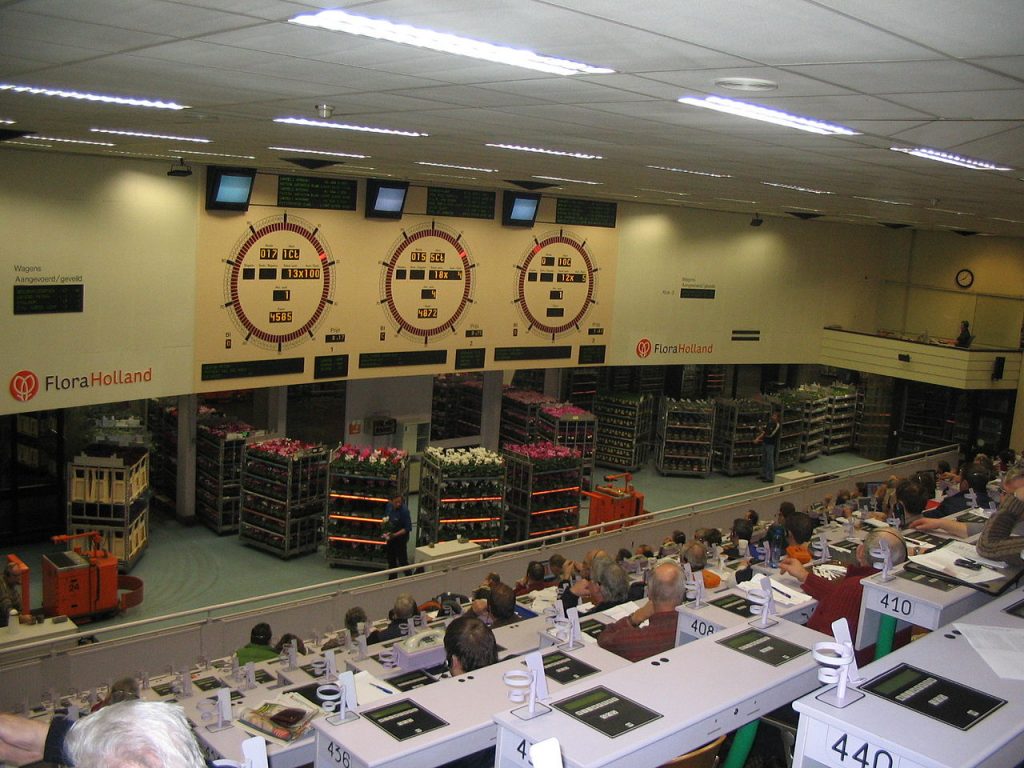What Is A Dutch Auction? Posted by Sten on Jul 31, 2018 in Culture
Back with our series on “Dutch”-terms, we are looking at another economic term, like the “Dutch disease” post last time. Today, we will look at the Dutch Auction – what is it about? Let’s find out.
Check out other “Dutch”-terms posts here.
Auctioning it the Dutch way
https://youtu.be/lN-n0_Sf5cE?t=1m24s
We have all seen auctions like the one above. The veilingmeester (auctioneer) begins with a low starting price, and different interested parties bring up the price by raising their hand and naming their price.
A Dutch auction works like that, but andersom (in reverse). Here, the starting price is high, and the veilingmeester gradually lowers the price until a deelnemer (participant) in the veiling (auction) accepts it. So this means that instead of many deelnemers often raising their hand, as we see it in a classical auction, the first deelnemer to steek de hand op (raise the hand) gets the deal.
The US Treasury also uses a Dutch auction to sell its securities. That is quite technical, and I will not explain it here. Read about it here.
Dutch Auction not Dutch in Dutch
Guess what? The Dutch auction is not Dutch in Dutch! Wait what? What do I mean by that?
Well, a Dutch auction in the Netherlands is actually called a veiling bij afslag (auction at reduction) or veiling bij afmijning (auction at “afmijning”).
Afmijning is actually an interesting term. It was already in use in the early 20th eeuw (century). It comes from getting rid of a product (ervan af komen), by shouting “mijn!” first when the veilingmeester reduces the price. You can see a great example of that at a huizenveiling (home auction) above. As the video explains, the selling price is first determined with the normal process of allowing the highest bidder to win. The veilingmeester then adds a certain bedrag (amount), and uses a Dutch Auction to determine the winner of the auction. Here, he counts down the price, and the first to roep (shout) “mijn!” (“mine!”) gets the huis (home).
So, a Dutch Auction is not called a Nederlandse veiling in Dutch. English also has other names for this type of auction: clock auction or open-outcry descending-price auction. The second term is quite self-explanatory. A clock auction is the digitized version of the process – a clock shows the amount asked, and it basically counts down, as the veilingsmeester would. You then press a button instead of shouting “mijn!”
How did the Dutch get involved?
So why is this form of auction Dutch? Well, it all started in the 1600s.
Back in those days, tulips were only introduced in the Netherlands from the Ottoman Empire. The problem with these bulbs: They took a long time to grow (sometimes more than 10 years!), hence they were quite rare, and because of that and because of their beauty, they were very expensive. So on the beurs (stock exchange) (also started in the Netherlands!), it made sense to sell bulbs quickly, with as few bids as possible and getting a price as high as possible – so start high, wait for the price to lower and the first person to take the bid goes fastest – and the Dutch auction was born. And because they were the pioneers, and it happened in an economic high time for the Dutch, it became prominent and the Dutch became known for it.
Thoughts? Comments? What do you think of the Dutch auction? Let me know in the comments below!

Build vocabulary, practice pronunciation, and more with Transparent Language Online. Available anytime, anywhere, on any device.





Comments:
Sandi:
The Dutch Auction is far superior to the typical auction. The latter works from greed of the seller, the former works from value for the buyer.